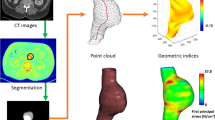Abstract
Aneurysms, especially in the abdominal aorta (AAA), are prone to rupture, and hence a reliable and easy-to-use predictor is most desirable. Based on clinical observations and numerical analyses, a semi-empirical equation for the peak AAA-wall stress has been developed. It can be readily used for AAA-rupture predictions or can be integrated into more elaborate AAA-assessment models.
Similar content being viewed by others
References
Cappeller, W. A., H. Engelmann, S. Blechschmidt, M. Wild, and L. Lauterjung. Possible objectification of a critical maximum diameter for elective surgery in abdominal aortic aneurysms based on one- and three-dimensional ratios. J. Cardiovasc. Surg. 38:623–628, 1997.
Di Martino, E. S., and D. A. Vorp. Effect of variation in intraluminal thrombus constitutive properties on abdominal aortic aneurysm wall stress. Ann. Biomed. Eng. 31(7):804–809, 2003.
Di Martino, E. S., G. Guadagni, A. Fumero, and G. Ballerini. Fluid–structure interaction within realistic three-dimensional models of the aneurysmatic aorta as a guidance to assess the risk of rupture of the aneurysm. Med. Eng. Phys. 23:647–655, 2001.
Elger, D. F., D. M. Blackketter, R. S. Budwig, and K. H. Johansen. The influence of shape on the stresses in model abdominal aortic aneurysms. J. Biomech. Eng. (ASME) 118:326–332, 1996.
Fillinger, M. F., M. L. Raghavan, P. Marra, L. Cronenwett, and E. Kennedy. In vivo analysis of mechanical wall stress and abdominal aortic aneurysm rupture risk. J. Vasc. Surg. 36:589–596, 2002.
Fillinger, M. F., P. S. Marra, M. L. Raghavan, and E. F. Kennedy. Prediction of rupture in abdominal aortic aneurysm during observation: Wall stress versus diameter. J. Vasc. Surg. 37:724–732, 2003.
Hall, A. J., E. F. G. Busse, D. J. McCarville, and J. J. Burgess. Aortic wall tension as a predictive factor for abdominal aortic aneurysm rupture: Improving the selection of patients for abdominal aortic aneurysm repair. Ann. Vasc. Surg. 14:152–157, 2000.
Hatakeyama, T., H. Shigematsu, and T. Muto. Risk factors for rupture of abdominal aortic aneurysm based on three dimensional study. J. Vasc. Surg. 33:453–461, 2001.
Holzapfel, G. A., T. C. Gasser, and R. W. Ogden. A new constitutive framework for arterial wall mechanics and a comparative study of material models. J. Elasticity 61(1–3):1–48, 2000.
Li, Z., and C. Kleinstreuer. Computational analysis of fluid–structure interactions in a stented aneurysm model. Computer Methods in Biomechanics and Biomedical Engineering, Vol. 8 (2005).
Limet, R., N. Sakalihassan, and A. Albert. Determination of the expansion rate and incidence of rupture of abdominal aortic aneurysms. J. Vasc. Surg. 14:540–548, 1991.
Matsumoto, T., and M. Sato. Analysis of stress and strain distribution in the artery wall consisted of layers with different elastic modulus and opening angle. JSME Int. J. C-Mech. SY 45(4):906–912, 2002.
Ouriel, K., R. M. Green, C. Donayre, C. K. Shortell, J. Elliott, and J. A. Deweese. An evaluation of new methods of expressing aortic aneurysm size: Relationship to rupture. J. Vasc. Surg. 15:12–20, 1992.
Raghavan, M., D. Vorp, M. Federle, M. Makaroun, and M. Webster. Wall stress distribution on three-dimensionally reconstructed models of human abdominal aortic aneurysm. J. Vasc. Surg. 31:760–769, 2000.
Sonesson, B., T. Sandgren, and T. Lanne. Abdominal aortic aneurysm wall mechanics and their relation to risk of rupture. Eur. Vasc. Endovasc. Surg. 18:487–493, 1999.
Stenbaek, J., B. Kalin, and J. Swedenborg. Growth rate of thrombus may be a better predictor of rupture than diameter in patients with abdominal aortic aneurysm. Eur. Vasc. Endovasc. Surg. 20:466–469, 2000.
Thurbrikar, M., J. Al-Soudi, and F. Robicsek. Wall stress studies of abdominal aortic aneurysm in a clinical model. Ann. Vasc. Surg. 3:355–366, 2000.
Uflacker, R., and J. Robison. Endovascular treatment of abdominal aortic aneurysms: A review. Eur. Radiol. 11:739–753, 2001.
Vardulaki, K. A., T. C. Prevost, N. M. Walker, N. E. Day, A. B. M. Wilmink, C. R. G. Quick, H. A. Ashton, and A. P. Scott. Growth rates and risk of rupture of abdominal aortic aneurysms. Br. J. Surg. 85:1674–1680, 1998.
Vorp, D. A., M. L. Raghavan, and M. W. Webster. Mechanical wall stress in abdominal aortic aneurysm: Influence of diameter and asymmetry. J. Vasc. Surg. 27:632–639, 1998.
Wang, D., M. Makaroun, M. Webster, and D. A. Vorp. Effect of intraluminal thrombus on wall stress in patient specific model of abdominal aortic aneurysm. J. Vasc. Surg. 3:598–604, 2002.
Wilson, K. A., A. J. Lee, P. R. Hoskins, F. G. Fowkers, C. V. Ruckley, and A. W. Bradbury. The relationship between aortic wall distensibility and rupture of infrarenal abdominal aortic aneurysm. J. Vasc. Surg. 37:112–117, 2003.
Zhao, S. Z., X. Y. Xu, and M. W. Collins. The numerical analysis of fluid–solid interactions for blood flow in arterial structures. Part 2. Development of coupled fluid–solid algorithms. Proc. Inst. Mech. Eng. Part H, J. Eng. Med. 212:241–252, 1998.
Author information
Authors and Affiliations
Corresponding author
Rights and permissions
About this article
Cite this article
Li, Z., Kleinstreuer, C. A New Wall Stress Equation for Aneurysm-Rupture Prediction. Ann Biomed Eng 33, 209–213 (2005). https://doi.org/10.1007/s10439-005-8979-2
Received:
Accepted:
Issue Date:
DOI: https://doi.org/10.1007/s10439-005-8979-2




